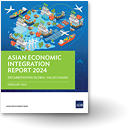Subregional Cooperation Programs in Archipelagic Southeast Asia


On the sidelines of the 20th Association of Southeast Asian Nations (ASEAN) Summit on 4 April 2012 in Phnom Penh, Cambodia, the Sixth Indonesia-Malaysia-Thailand Growth Triangle (IMT-GT1) Summit and the Eighth Brunei Darussalam-Indonesia-Malaysia-Philippines East ASEAN Growth Area (BIMP-EAGA2) Summit endorsed their respective Implementation Blueprints (IBs) for 2012–16.
The IBs aim to increase project delivery through annually updated two-year rolling pipelines and strengthened institutional mechanisms. The IMT-GT supports development of five economic corridors through sector strategies in transport and energy; trade and investment; agriculture; halal products and services; tourism; and human resource development. BIMP-EAGA pursues a four-pronged strategy enhancing connectivity, establishing BIMP-EAGA as food basket for ASEAN (and the rest of Asia), promoting BIMP-EAGA as a premier regional tourism destination, and ensuring sustainable management of the environment.ADB, through its Southeast Asia Department (SERD), has acted as Regional Development Advisor to BIMP-EAGA since 2001 and a Development Partner of IMT-GT since 2006. ADB supports these subregional groupings through regional technical assistance, providing strategic, policy and technical advice along with capacity building and institutional support, especially for regional secretariats.3
Launched in 1993 and 1994, respectively, the IMT-GT and BIMP-EAGA cooperation programs cover primarily archipelagic areas at the subnational level. 4Though independent, both programs were established to help promote socioeconomic development in less developed and disadvantaged areas by increasing trade, tourism, and investment—backed by an underlying strategy of mobilizing the private sector as engine of growth. The IMT-GT is a natural geographical, historical, cultural and linguistic bloc. BIMP-EAGA is linked by a long history of trade and economic relations. The IMT-GT focuses on promoting economic and information exchange for corridor development. BIMP-EAGA has progressively worked toward greater labor mobility and trade in goods and services. Driven by the need to further integrate with the rest of Asia, both programs have been increasingly project-oriented.In2009, BIMP-EAGA and IMT-GT Leaders endorsed priority infrastructure projects to strengthen connectivity, including both “hard” and “soft” infrastructure. These are now part of the IB project pipelines. An integral part of the programs’ evolution is the process of strengthening subregional and national institutional processes and operational mechanisms.
Both IMT-GT and BIMP-EAGA subregional cooperation programs aim to converge with ASEAN’s goals, supporting the Master Plan on ASEAN Connectivity. The two subregional programs are test-beds for ASEAN agreements and key building blocks for realizing an ASEAN Community by 2015. ADB supports these subregional groupings—along with the Greater Mekong Subregion—promoting subregional-national synergies and linkages for regional cooperation and integration in Southeast Asia.




